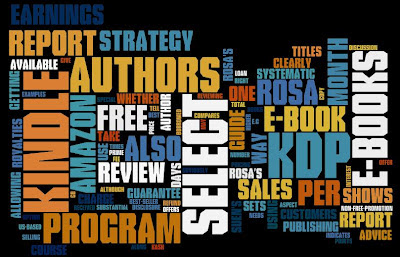
In this post last week I reviewed Rosa Suen's report on publishing to the Amazon Kindle.
Today I'm reviewing her companion KDP Select Report - also available as a Warrior Special Offer - about the benefits to authors of opting into the KDP Select program.
For those who don’t know, KDP Select is a new program allowing authors of Kindle e-books to earn money by allowing their titles to be lent out to US Amazon Prime customers (though authors don’t have to be US-based themselves). Such customers are allowed to borrow one Kindle e-book free of charge per month under the program.
Obviously, authors don’t get any royalties from this program - as their books are loaned out free - but Amazon has set aside a substantial fund (an estimated $6 million during 2012), which is shared out every month according to how many times each e-book has been borrowed. With low-cost e-books - as Rosa's report indicates - your earnings per loan are almost certain to be higher than your royalties per sale.
The KDP Select program has been the cause of much discussion among Kindle authors, with some contending it offers a poor deal for authors. This is largely because, if you want to take part, you are barred from selling your e-book digitally through any other outlet (e.g. Smashwords) during the (minimum) 90-day period your title is available through the program. Rosa is the author of around 200 (non-fiction) e-books, however, and she shows clearly through her own sales figures and earnings that the program can be very effective if you use it in the right way.
One key aspect of the advice in the KDP Select Report concerns how to use the opportunity KDP Select authors are given to list their e-books free of charge on Amazon for up to five days per month (consecutive or otherwise). With stats from ten different e-books, Rosa clearly shows the effectiveness of this strategy for generating interest in an e-book and getting it into the Amazon best-seller lists.
She compares the number and value of sales generated (on non-free-promotion days, obviously) with loans per month, and shows the total earnings in each case. She discusses how she intends to refine her sales and pricing strategy to maximize her earnings from each title, and also sets out what she has discovered about the best price points for Kindle e-books.
I found Rosa’s systematic approach to marketing using the KDP Select program impressive, and the specific case studies quite enlightening. The guide doesn’t actually tell you anything about devising or writing Kindle e-books, though as previously mentioned Rosa does have another report, also available as a WSO, which covers this subject. And, of course, my own Kindle Kash guide sets out step-by-step advice on publishing an e-book to the Kindle Store using only free resources.
If you’re a Kindle author and have been wondering whether to take the plunge with KDP Select, I recommend this modestly priced guide. It may not have all the answers, but I guarantee it will give you food for thought. It also demonstrates a systematic, mathematically-based way of analysing the returns you are getting from applying Rosa’s strategy and fine-tuning it to boost your profits further. Incidentally, along with the report you also receive 10 charts (plus one already filled in as an example) to help you apply the strategy to your own titles.
With this report, as with Rosa's original one, there is a 30-day unconditional refund guarantee.
Disclosure: I received a free review copy of Rosa Suen's KDP Select Report. In addition, the links in this review include my affiliate code, so if you click through and make a purchase, a proportion of the fee will go to me. This has not influenced my review in any way, but you should of course complete your own due diligence and read the sales page (and this review) carefully to determine whether this product will be relevant to your needs.
Word cloud by courtesy of Wordle.
No comments:
Post a Comment